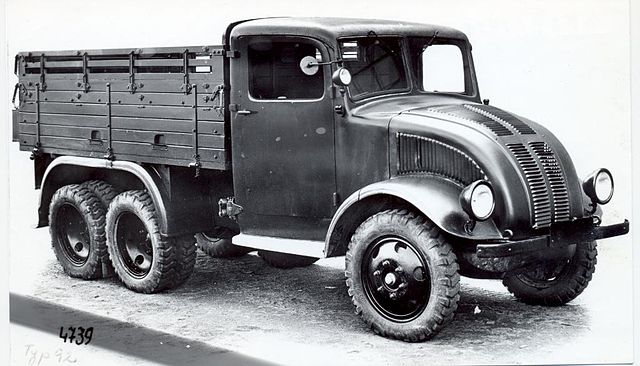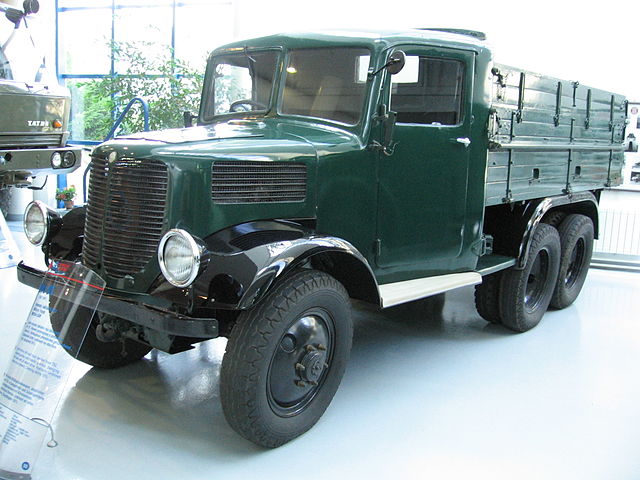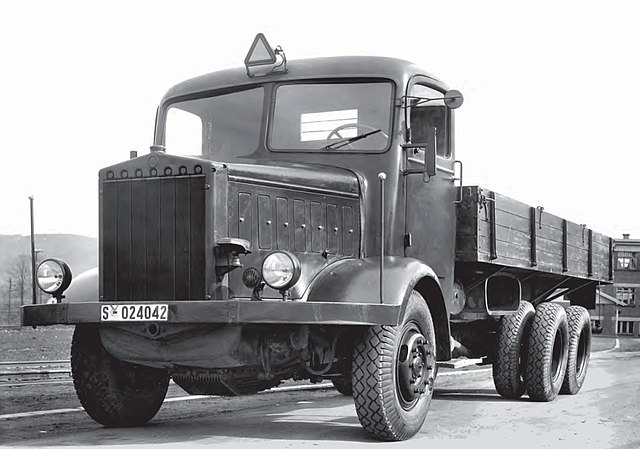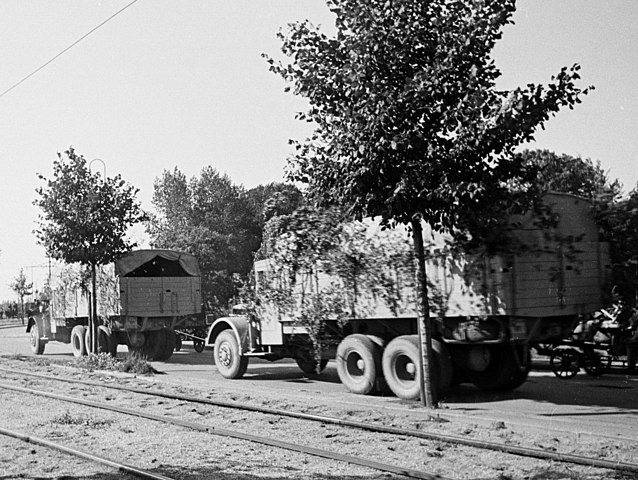LIAZ
 LIAZ MT
LIAZ MT
LIAZ as a company was created in 1951 from the division of Skoda. The acronym came from "LIberecké Automobilové Závody". The company specialized in trucks and its first products were the R series (1952–1958) which suceeded the RT series (1957–1990) and MT series (1969–1990). LIAZ 100-400 series: The only military ones were the 200 series from 1991, delivered in 4WD versions. The 100 series sarted in 1974, the name ŠKODA LIAZ was dropped in 1990, but LIAZ is defunct from September 1, 2003, and reverted to a simple integrated division of ŠKODA today.
Tatra
 Tatra 26 one of the first successful interwar Tatra truc family. Designed by Hans Ledwincka, the first serie was produced in 1926-1927 followed in 1927-1931 by the Tatra 26/30 and 1931-1933 by the 26/52. Most were still around in WW2.
Tatra 26 one of the first successful interwar Tatra truc family. Designed by Hans Ledwincka, the first serie was produced in 1926-1927 followed in 1927-1931 by the Tatra 26/30 and 1931-1933 by the 26/52. Most were still around in WW2.
Origins and WWI
Tatra was a Czech vehicle manufacturer of Kopřivnice, third oldest car marker in the world with an unbroken history as it was founded in 1850 as Ignatz Schustala & Co, and renamed in 1890 as the German Nesselsdorfer Wagenbau-Fabriksgesellschaft, and start producing wagon and carriages. In 1897, Tatra made the very first motor car in the whole of Central Europe, the "Präsident".
In 1918, the company became Kopřivnická vozovka a.s.. In 1919 it adopted the Tatra badge, and took the name of the nearby Tatra Mountains, on the Czechoslovak-Polish border.
Interwar
The interwar saw Tatra taking an international stature, not only with its range of sturdy, affordable cars (using its trademark backbone tube chassis fropm the engineer Ledwinka) combined with reliable in-house air-cooled engines. The Tatra 11 (1923) was one of such success. The company pioneered aerodynamics, notably with the spectacular Tatra 77 (1934) and streamlined later its whole range. The company was also famous for its trucks.
In 1919 already, the TATRA apeared on first mass produced trucks since 1914, the NW TL2 and NW TL4 used by the Autro-Hungarian Army. Kopřivnická vozovka, a.s. was integrated into the Ringhoffer Corporation and by 1936 the company evolved, and was renamed Ringhoffer TATRA Werke A G in 1938 after the partition.
Tatra 57/57K (1932-1940)

The Tatra 57 were popular two-door compact cars built from 1932 and known as the "Hadimrška". The model was upgraded as the 57A in 1936, 57B in 1938 but as the company soon fell under German supervision, a military adaptation was quickly derived, the 57K, (L standing for Kübelwagen) which production spanned 1941-1945, woth more than 5,000 Tatra Kübelwagens delvered. The "Leichter Personenkraftwagen" (le. Pkw.) Tatra 57" in German ordnance was often used by the Gestapo in central Europe.

Tatra 72 (1932)

The Tatra 72 was an army off-road truck derived from the Tatra 26 () manufactured between 1933 and 1937. It was mainly used for transporting military cargo (mainly ammunition), personnel and towing artillery pieces in Czech and later German armies. The design was also license-built in France by Lorraine-Dietrich, as the Lorraine 72.
Tatra 82 (1935)

The Tatra 82 was a heavy-duty car produced bewteen between 1935 and 1938, mainly used for military cargo and personnel, as a large staff car. It was given an air-cooled OHC 4-cylinder boxer engine (2490, 55 hp) on 3 axles and a gearbox with 8 fwd gears and one reverse gear. Loaded at 3,150 kg (6,945 lb) it still reached 65 km/h (40 mph). 325 were produced, the last given the V8 from the Tatra 87.
Tatra 92 (1937)

 Early and late Tatra 92
Early and late Tatra 92
The Tatra 92 was an army off-road truck manufactured between 1937 and 1941, transporting military cargo and personnel, declined as an ambulance, field kitchen and utility mobile workshop. Construction went on from 1938 under German supervision to proviede the Wehrmacht as well and was prominetl used on th eastern front although most went to Romania. It was powered by an air-cooled OHC V8 engine and in 1939, 80 Tatra 93 were converted as true 6x6 fr the Romanian Army only. 200 Tatra 93 trucks were acquired Romania in all, for 529 produced in all until late 1941. The Germans then pressed for a new model, which was the famous Tatra 111.
Under Nazi rule 1938-1945
Following the 1938 German-Czechoslovak war and Munich Agreement, the town of Kopřivnice was occupied by Nazi Germany and Tatra's production was directed towards military production. Trucks like Tatra 111 (1942) became instrumental both for the German Nazi war effort as well as post-war reconstruction in Central Europe and Soviet Union.
Tatra 81 (1939)

The Tatra 81 was the heavy-duty Tatra truck, produced between 1940 and 1942, with its development ordered by German government to be used by the Ordnungspolizei, and the Wehrmacht as heavy cargo. It had a large 8-cylinder diesel (12,467 cc) capable of 117.8 kW (158.0 hp) and the naked chassis was 5,700kg alone, with a 6,500 kg payload and still capable of 65 km/h (40 mph). Only 220 were produced.
Tatra 111 (1939)

The T111 was entirely developed by Hans Ledwincka under German supervision and specifications. It was manufactured as a heavy truck to be mass-produced for the Wehrmacht, starting in 1942 and until 1945, but the base vehicle was so good, production resumed and went on under Soviet supervision for twenty more years, until 1962 and the the Tatra 138. Total production was above 50,000, with perhaps 2,000 during the war.

Under Soviet supervision
After 1945 the company became famous for its TATRA 111, which remained in production for the next 16 years and until 1962. It became so successful it earned its its own monument. It was later derived into the T 141 heavy towing vehicle.
Another "legend" was the 1959 TATRA 138, further developed into the T 148 version range. It gaained a new 8-cylinder and synchronized transmission with inter-axle differentials. Heavy tatra trucks were widely used in Eastern Europe, less in USSR as considered a bit too complex, but their excellent reputation made them exported to 53 countries on five continents. At the end of the sixtie, Tatra presented a cab-over-engine design, the T 813 8x8 Kolos, first four-axle with the 12-cylinder air-cooled diesel and new transmission enabling 20 forward gears, 4 reverse.
100,000 T 148s had been cranked up when the line closed in 1982, but the ranges were fusioned into the T 815 (COE cab and later EURO 2 spec engine).
The Trambus T 815 was powered by a new air-cooled V8 engine with supercharging and intake air cooler which power was more than doubled over time. After the fall of USSR and partition, in 1989 LIWA project was launched but only for a short time.
Tatra Today
Today, Tatra's production focuses on heavy off-road trucks based on its century long development of backbone chassis, swinging half-axles and air-cooled engines. Core of its production are Tatra 817 intended primarily for military operators and Tatra Phoenix (Tatra chassis with DAF cabin and Paccar water-cooled engine) aimed primarily for civilian market. In 2023, the company plans to produce over 2.000 trucks.
Post-WW2:
Tatra 138 (1959-71)
Tatra 148 (1972-82)
Tatra 158 Phoenix (2011)
Tatra 163 (1999)
Tatra 810 Mil (2008)
Tatra 813 Mil (1967-82)
Tatra 815 (1983)
Tatra 815-7 Mil (2008)
Src/ read More
Tatra wiki
Avia wiki
okiemtruckera.pl
LIAZ wiki
cat wiki
liaz.cz/
avia.cz
Videos